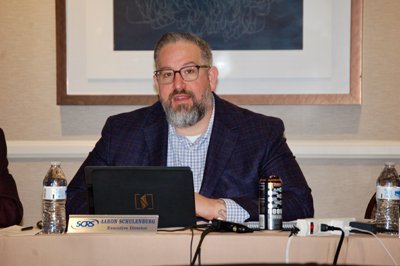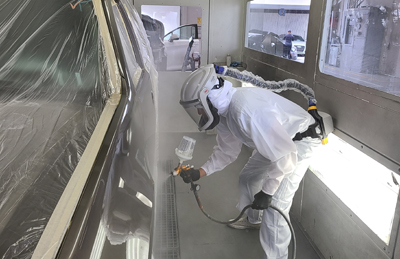The Society of Collision Repair Specialists (SCRS) is having “positive dialogue” with all three estimating system providers regarding refinish blend formulas following an SCRS study last year the association believes demonstrated blending takes more time than a full panel refinish, rather than the 50% less time allocated in the three estimating systems.
At a board meeting earlier this year, Aaron Schulenburg, executive director of SCRS, said CCC Intelligent Solutions and Motor Information Systems, which develops the underlying repair data used by the CCC estimating system, have “committed to doing research and replying back to us” by the end of March, and “I think we’re having the same types of positive dialogue with the other two companies.”
He said the companies have said “the amount of pressure they have received since November as a result of this is putting them in a position where they have to look at it, and respond in some way, shape or form,” and the association is “choosing to give them a little latitude to let them go through their processes, because I want to believe that is going to lead to a better outcome.”
“I don’t expect, and I certainly hope that they wouldn’t simply adjust values because any one group said they should,” Schulenburg said. “I would hate to think that any other group might go to them and ask them to lower a value and that they would just do it because they were asked to. What I do think is we provided very meaningful data, very meaningful research, that was conducted impartially, with a lot of different parties that validated how it occurred, and that it provides enough to get them to do what we’ve asked them to do all along: re-evaluate whether 50% really reflects” what blending requires.

Debate Over Blend Formula Not New
The disagreement over the blend formula stretches back more than a decade; in 2008, for example, the Automotive Service Association issued a position statement arguing blending requires as many procedures as refinishing a new undamaged panel, and calling for the information providers and insurers to acknowledge the additional labor and materials required to facilitate adjacent panel color matching.
Schulenburg said SCRS undertook its blend study because the industry repeatedly asking the information providers to review their formulas---or share details about how they arrived at their formula---over decades didn’t result in any action. The information providers stood by their formulas and said their test results were proprietary, he said at an SCRS open board meeting.
“But our members have always said: painting a panel from edge to edge is easier and less time-consuming than it is to create an invisible transition of color to facilitate a color match,” Schulenburg said. “Shops say they can take someone with less skill and teach them how to paint a panel from edge to edge [more easily than] teaching somebody how to create that invisible transition within the panel. That the process takes more time because you’re blending not into a new panel, but an adjacent panel that’s been on the vehicle and collecting road debris and needs to cleaned and masked and prepped in different ways.”
In sharing its blend study findings with the information providers, Schulenburg said, the association also noted changes that have occurred since the information providers’ blend formulas were developed decades ago.
“Colors today are not the same as they were 30 years ago,” he said. “Cars today are not the same as they were 30 years ago. Consumer expectations today aren’t what they were 30 years ago. It is all so much more complex. The expectations are so much greater. The colors are so much harder, so much richer and deeper. Matching them is difficult, and consumers expect more because they spend a whole lot more on their car today than they did 30 years ago. That’s just the reality that we live in.”
Share the Study Findings
He encouraged shops to share the blend study with their colleagues in the industry.
“Don’t encourage them what to do,” Schulenburg cautioned. “The data speaks for itself. They can make their own informed business decisions. Just share the information.”
He said shops can also ask their sales representatives for the estimating systems they use “what their company is doing to address this.”
He said SCRS sees opportunities to address other issues, beyond the blend formula, using a similar process to its blend study.
“There are a lot of issues in the industry where the numbers don’t make sense, where they don’t reflect what our technicians go through, where they don’t reflect the technology changes that have occurred in the equipment or the vehicles,” he said. “I believe we have other studies we can conduct in a similar manner to advance the industry and provide good research and educational material that will inform people.”
Also at the meeting, SCRS said its Blueprint Optimization Tool (BOT), which audits estimates looking for potentially missed operations or line items, now has prompted users within shops to add more than 66,000 operations they are performing to their estimates since the product’s launch in 2020.









John Yoswick